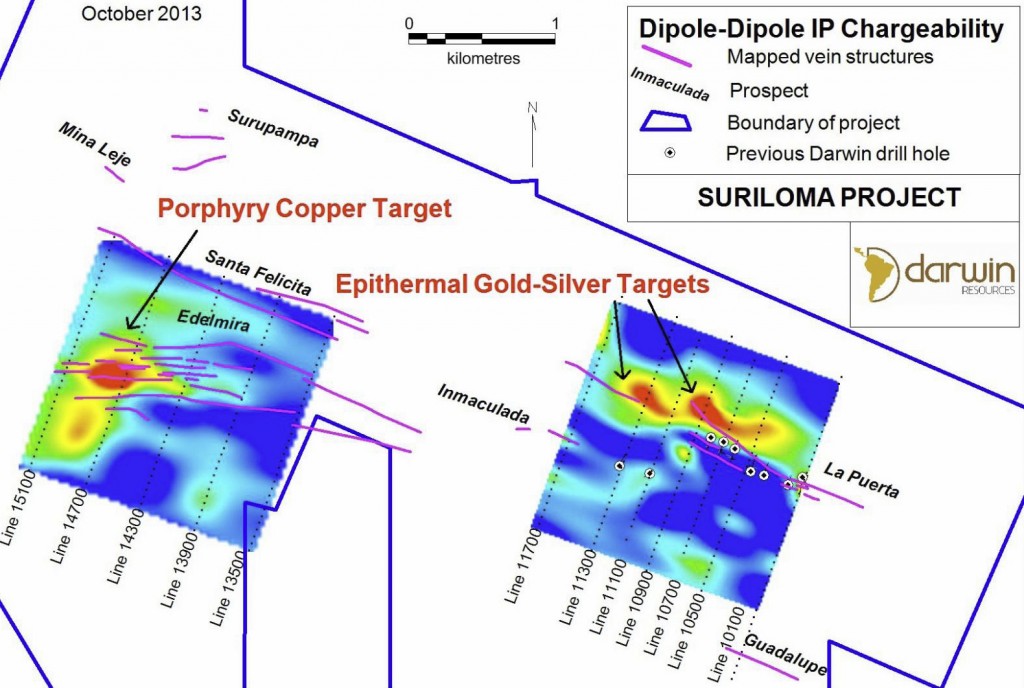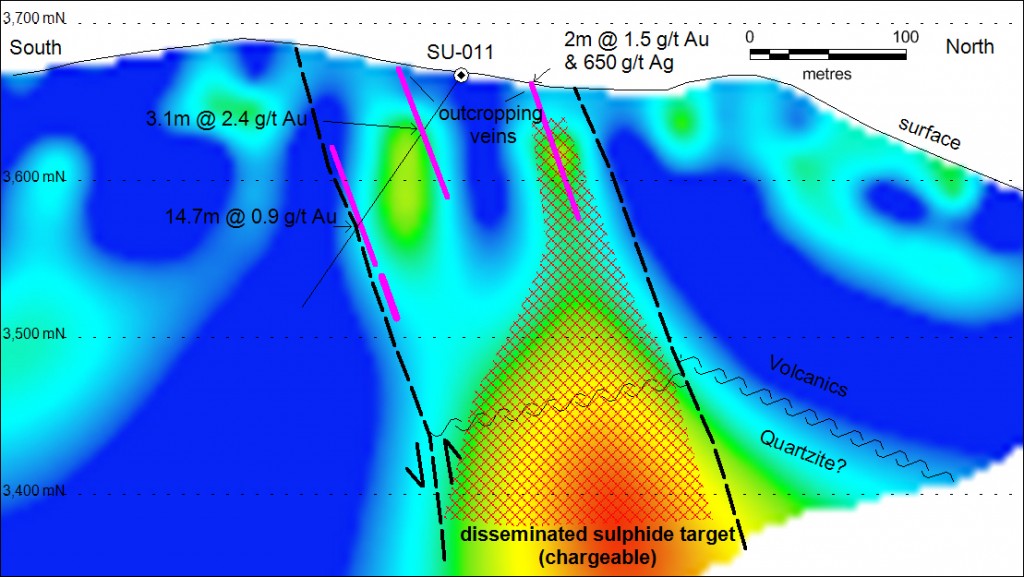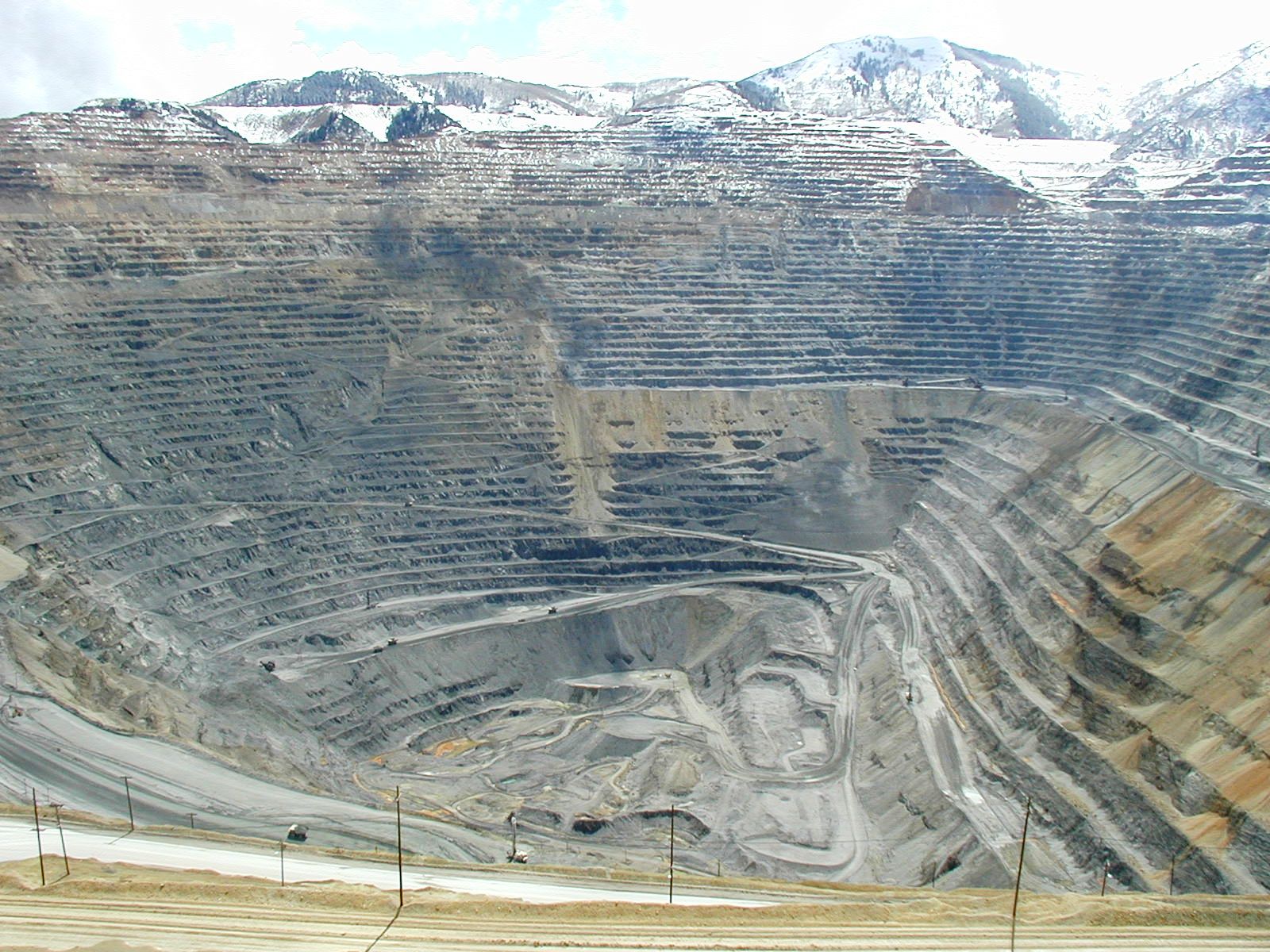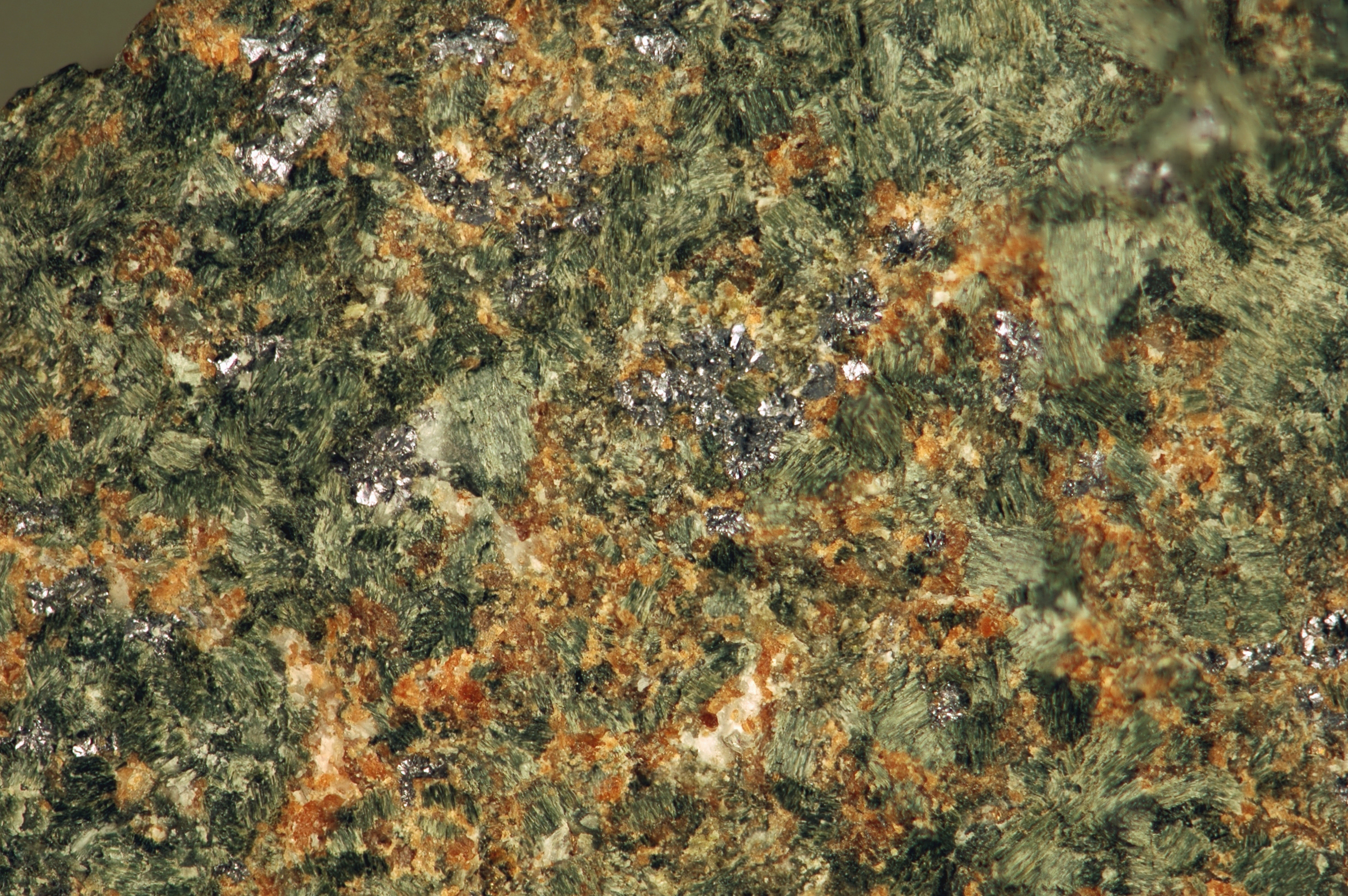It looks like Darwin’s shallow drilling missed this geophysical target entirely. Even though drilling is expensive, many companies rush into drilling without doing their homework. This simple geophysical survey could have easily been done prior to drilling.
[box type=”info” align=”aligncenter” ]Disclaimer: This is an editorial review of a public press release and may include opinions or points of view that may not be shared by the owners of geologyforinvestors.com or the companies mentioned in the release. The editorial comments are highlighted so as to be easily separated from the release text. Please view the full release here.[/box]
VANCOUVER, BRITISH COLUMBIA–(Marketwired – Oct. 28, 2013) – Darwin Resources Corp. (“Darwin” or “the Company”) (TSX VENTURE:DAR)(PINKSHEETS:DARWF) (FRANKFURT:DWU) reports results from a dipole-dipole induced polarization (“IP”) geophysical survey at the Suriloma project in the Department of La Libertad, Peru.
[box type=”note” align=”aligncenter” ]Darwin Resources Suriloma gold project is located in northern Peru about 30 km northwest of Barrick Gold’s Lugunas Norte mine. It is an early exploration stage project with several epithermal gold and copper-gold porphry prospects within it’s project area.
This past summer Darwin ran a small drill program consisting of 9 shallow diamond drill holes for a total of 1600 m drilled. Darwin was no doubt hoping for some intersections with high grade epithermal veins system, but instead they got narrow intersections of low to moderate grade of gold associated with sulfide minerals. Not particularly exciting compared to some of the bonanza grade epithermal deposits in the region.
We’ve talked before about how the textures and mineralogy of rocks in a mineralized system can be more important for a geologist than assays – especially in early-stage projects. In systems that have been strongly influenced by hydrothermal activity, the rocks retain clues about the temperature, depth and composition of the fluids.
So what? Well Darwin has used the clay mineralogy to theorize that the drilled vein systems were subject to temperatures that were too low for a high grade epithermal gold system. Since the vein system clearly has gold in it, they want to trace the system deeper in the hopes of finding a higher temperature, high grade gold system.
This is where the geophysics come in. Unlike MT and EM surveys which look for large conductive bodies, IP surveys look for “chargeable masses” and are better suited for locating disseminated (dispersed) mineralization within a rock mass. Darwin’s use of this type of survey would seem to indicate that they are looking for a discontinuous mineralized system, but in reality they probably used this survey type to save money: IP surveys are well suited for defining Copper-gold porphyry systems where the mineralization is discontinuous. Porphyry systems are genetically linked to epithermal gold deposits and, depending on their depth can be significant economic mineral deposits in their own right. Darwin’s choice of an IP survey allows them to cover both possible deposit types with one survey.
Peru is know for both epithermal gold and copper porphyry deposits.
[/box]
Key points:

- The survey highlighted a number of strong geophysical anomalies that support the interpretation that recent diamond drilling intersected the upper, low-temperature part of an epithermal vein system and point toward a number of large-scale untested gold and copper targets at depth;
- At the La Puerta area, an IP anomaly has been defined over 1300 metres by 200 metres, extending from a depth of 200 metres to the limit of the survey depth at 300 metres depth. The anomaly is interpreted to be the disseminated sulphidic core to the gold mineralization observed in shallow drilling;
- At the Edelmira area located 4 kilometres to the west of La Puerta, an IP anomaly has been mapped over an area of 400 by 300 metres open to the west. The anomaly is located at 250 metres depth and is interpreted to reflect the upper parts of a buried porphyry copper system.
Dr Graham Carman, President and CEO, states: “The IP survey has confirmed the presence of large-scale chargeable targets that lie immediately beneath the gold-bearing structures drilled 2 months ago. The survey has significantly increased the prospectivity of the area and we look forward to drill testing these exciting epithermal gold and porphyry copper targets.”
In total, 19.1 line-kilometres of dipole-dipole IP were surveyed on two separate grids (Figure 1), including at the La Puerta area where the Company previously reported encouraging gold intersections in several shallow drill holes, including 13.1 metres @ 1.4 g/t gold from 50.8 metres from hole SU-003 and 14.7 metres @ 0.9 g/t gold from 123.2 metres in hole SU-011 (see Darwin Press Release August 19 2013).
[box type=”note” align=”aligncenter” ]We’ve included Figure 1 referenced by Darwin below. The chargeable masses are in red. There are a few things worth noting:
- The diagram 1 shows the interpreted chargeable mass at a depth of 250 meters only. It is a 2-dimensional slice of the survey results and show nothing above or below the 250 m depth.
- Also note the line spacing. These are the lines used to take the geophysical readings. The interpretations between the lines are just that – interpretations. The tighter the line-spacing, the higher the resolution of the results. Note that the grid on the left is widely spaced at about 500 m versus the grid on the right leaving it much more open to interpretation.
[/box]

Modelling of the IP survey at La Puerta shows a steeply north-dipping tabular zone of conductive rocks up to 200 metres wide, which is interpreted to be the down-dip continuation of clay altered volcanic rocks associated with outcropping epithermal veins. At the base of the conductive zone a chargeability anomaly has been mapped over 1300 metres by 200 metres, extending from a depth of 200 metres to the limit of the IP model at 300 metres depth from surface (Figures 2 and 3). It is interpreted that the chargeability anomaly reflects sulphide mineralization at or near the contact with quartzite metasediments lying beneath the younger andesite volcanics. This is a high-priority drill target. The quartzite sediments are the preferred host rocks at large gold deposits elsewhere in the La Libertad region of Peru. Earlier drilling at La Puerta tested part of the epithermal vein system down to an average depth of only 65 metres and did not drill to sufficient depth to intersect the chargeable anomaly identified in the IP survey.
An extension of the IP survey 4 kilometres to the west at the Edelmira area defined a chargeability anomaly at a depth of 250 metres, which has dimensions of 400 by 300 metres and remains open to the west (Figure 1). This chargeability anomaly lies immediately beneath outcrops of copper-silver-gold bearing veins with quartz-sericite alteration, and is interpreted to reflect the upper parts of a buried porphyry copper system based on the Company’s experience elsewhere in Peru.
[box type=”note” align=”aligncenter” ]We’ve also included Figure 2 referenced above. Note that this is an interpreted cross-section along a single line of the survey. As with the first diagram, it is a 2-dimensional slice of the results.
It looks like Darwin’s shallow drilling missed this geophysical target entirely. Even though drilling is expensive, many companies rush into drilling without doing their homework. This simple geophysical survey could have easily been done prior to drilling. It will be interesting to see what they find down there.
[/box]

The qualified person, Dr Graham Carman, Darwin’s President and CEO, and a Fellow of the Australasian Institute of Mining and Metallurgy, has reviewed and verified the technical contents of this release.
About Darwin Resources Corp. (TSX VENTURE:DAR)(PINKSHEETS:DARWF)(FRANKFURT:DWU):
Darwin is a resource acquisition and development company focussing on Peru. The Company has an option to acquire 100% of the Suriloma gold and copper property in the Department of La Libertad.
On behalf of the Board,
Dr Graham Carman, President & CEO
[toggle title=”We’ve skipped some of the boilerplate. You can read it in here.” state=”close”]
Forward Looking Statements: This Company News Release contains certain “forward-looking” statements and information relating to the Company that are based on the beliefs of the Company’s management as well as assumptions made by and information currently available to the Company’s management. Such statements reflect the current risks, uncertainties and assumptions related to certain factors including, without limitations, failure to successfully complete intended financings, capital and other costs varying significantly from estimates, production rates varying from estimates, changes in world metal markets, changes in equity markets, uncertainties relating to the availability and costs of financing needed in the future, equipment failure, unexpected geological conditions, imprecision in resource estimates or metal recoveries, success of future development initiatives, competition, operating performance, environmental and safety risks, delays in obtaining or failure to obtain necessary permits and approvals from local authorities, and other development and operating risks. Should any one or more of these risks or uncertainties materialize, or should any underlying assumptions prove incorrect, actual results may vary materially from those described herein. Although Darwin believes that assumptions inherent in the forward-looking statements are reasonable, forward-looking statements are not guarantees of future performance and accordingly undue reliance should not be put on such statements due to the inherent uncertainty therein.
[/toggle]
[box type=”success” align=”aligncenter” ]Have a company or release you’d like us to look at? Let us know though our contact page, through Google+, Twitter or Facebook.[/box]






